Public Pier — No Fishing License Required
This pier, together with the other piers along this stretch of coast, provides both recreational fishing and a relief from the summer heat for those who come over from the hot Central Valley (and the summertime influx of Valley residents has earned this region the nickname “Redneck Riviera” or “Bakersfield’s Riviera” — take your pick. Some in Pismo Beach claim their beach is THE Central Valley’s beach but I think most residents of Pismo Beach itself, and the home towns of the other CenCal piers—Avila, Morro Bay, Cayucos and San Simeon, might disagree.

The Boardwalk along the beach
Still there is some truth in regard to the visitors from the Valley and it reminds me of the old Johnny Horton song— “When it’s springtime in Alaska it’s forty below.” The new verse would say “when it’s summertime in Fresno it’s a hundred degrees or more.” The good thing is that if you head over to Pismo Beach and decide to bop into the Splash Café for some clam chowder you never know which friend from Fresno you’ll run into.

This has been the case since the late 1800s. In 1881 a wharf was built on this site and then, in 1895, a dance pavilion was built near the foot of the pier. During the summer a “Tent City” would spring up as tourists flocked to the beach and the hotels became over crowded. The result, both then and now, is that Pismo Beach and other central coast piers are often crowded June through August, and are fairly quiet the rest of the year—a fact that local anglers didn’t seem to mind in the past.

An empty pier during reconstruction — 2017
But, that may be changing. The summertime parking by the pier, that could be truly gnarly at times. is now almost impossible and simply finding a place to park anywhere downtown can be a challenge. On summertime weekends it’s more than a challenge. It will be interesting to see how the city responds to the increased number of people that flood their fair city.

Pismo’s pier, with an estimated million and a half visitors per year, is the most heavily fished and second most productive of the central coast piers. However, fishing can be somewhat unpredictable. It all depends on the rich influx of microscopic plankton and baitfish that accompany the upwelled waters along this beautiful stretch of coast, a mix that can vary year to year depending upon the springtime winds and changes in ocean currents. Rich water means food and larger fish but if the planktonic food is absent the schools will also be absent. Hapless anglers are at the mercy of these waters and the fish that show up to partake of the offerings. Luckily most years the upwelling takes place and a variety of schooling species does show up.
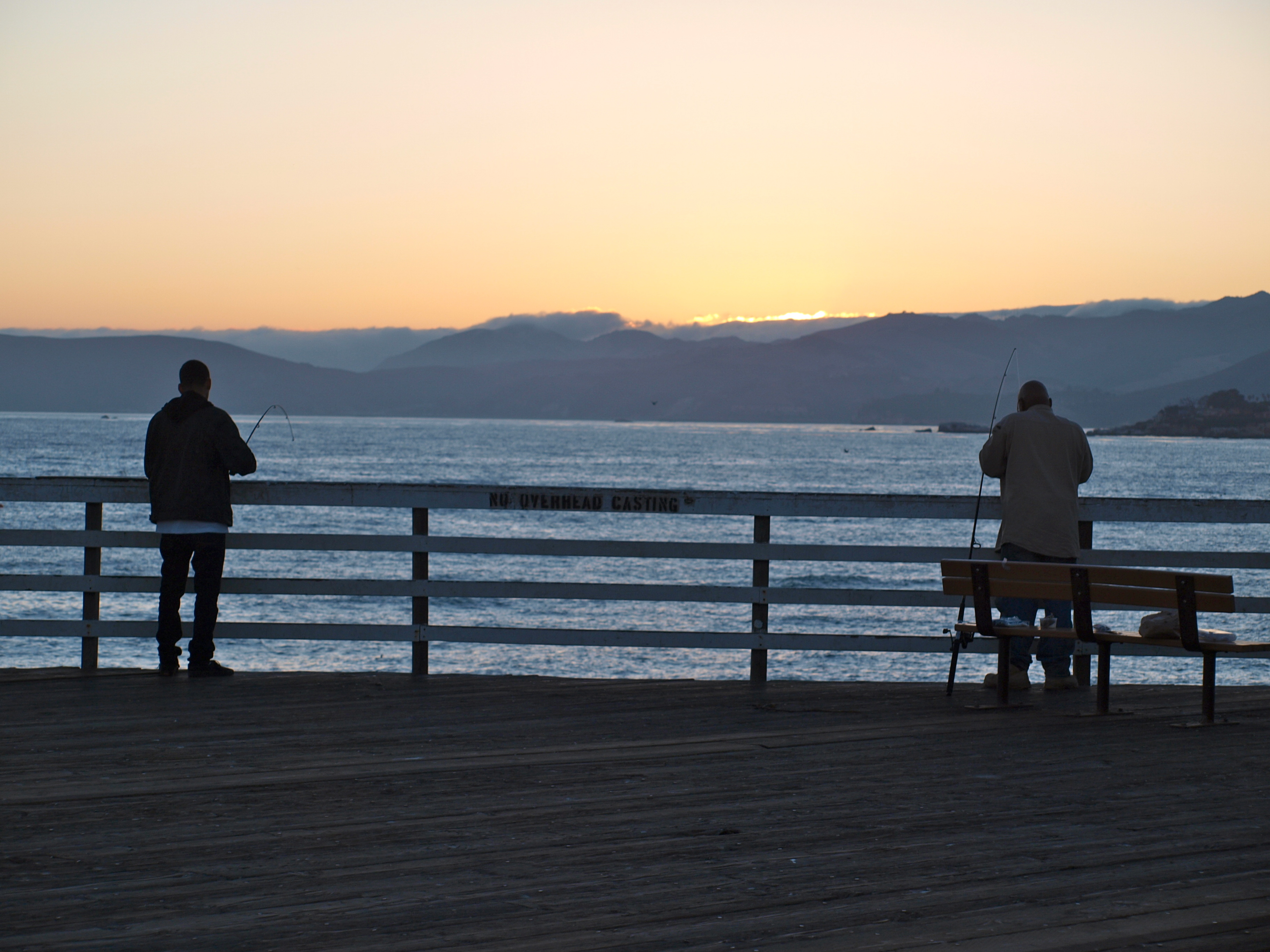
The main example used to be the baby bocaccio that would invade the shallow waters around the piers each summer. Although they didn’t emulate Capistrano’s swallows and show up the same day each year, they would usually be present by July. In response, people would flock to the piers to catch the “snapper” by the bucketful (even though the limit was 15). Today the bocaccio are less common, in fact the limit is now two, and some years they even fail to make an appearance. Luckily the jacksmelt, Pacific mackerel and Spanish mackerel (jack mackerel) are still present and Pacific sardine, a fish that was rarely seen for decades, has joined them. Hopefully the bocaccio will also return.
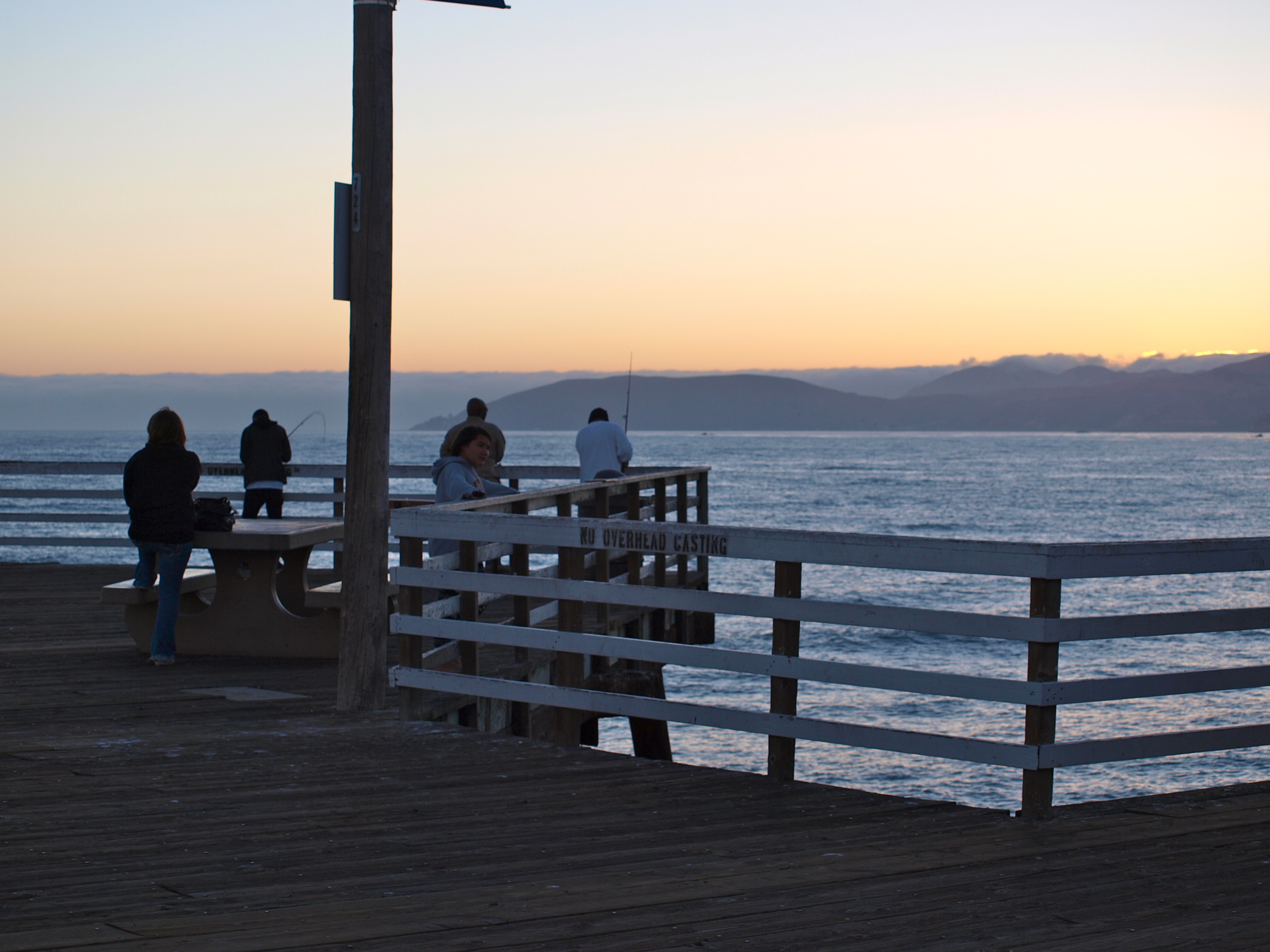
Whatever the pelagic species, when the schools are present anglers will fill their buckets. When the big schools are gone anglers must rely on the more year-round, resident species and often that means just a fish or two per trip.
Environment. Today’s Pismo Beach Pier is 1,370-foot-long (some sources say 1,250 feet) and 32-feet-wide with the surface 25-feet above the water; it also has several cantilevered fishing decks that make it easier to fish down around the pilings. At the same time the pier seems to face straight on to the waves and generally the first half of the pier sees water that is subject to heavy wave action. That’s good for perch fishing but not so good for some of the other species—or keeping the rigging in one spot.
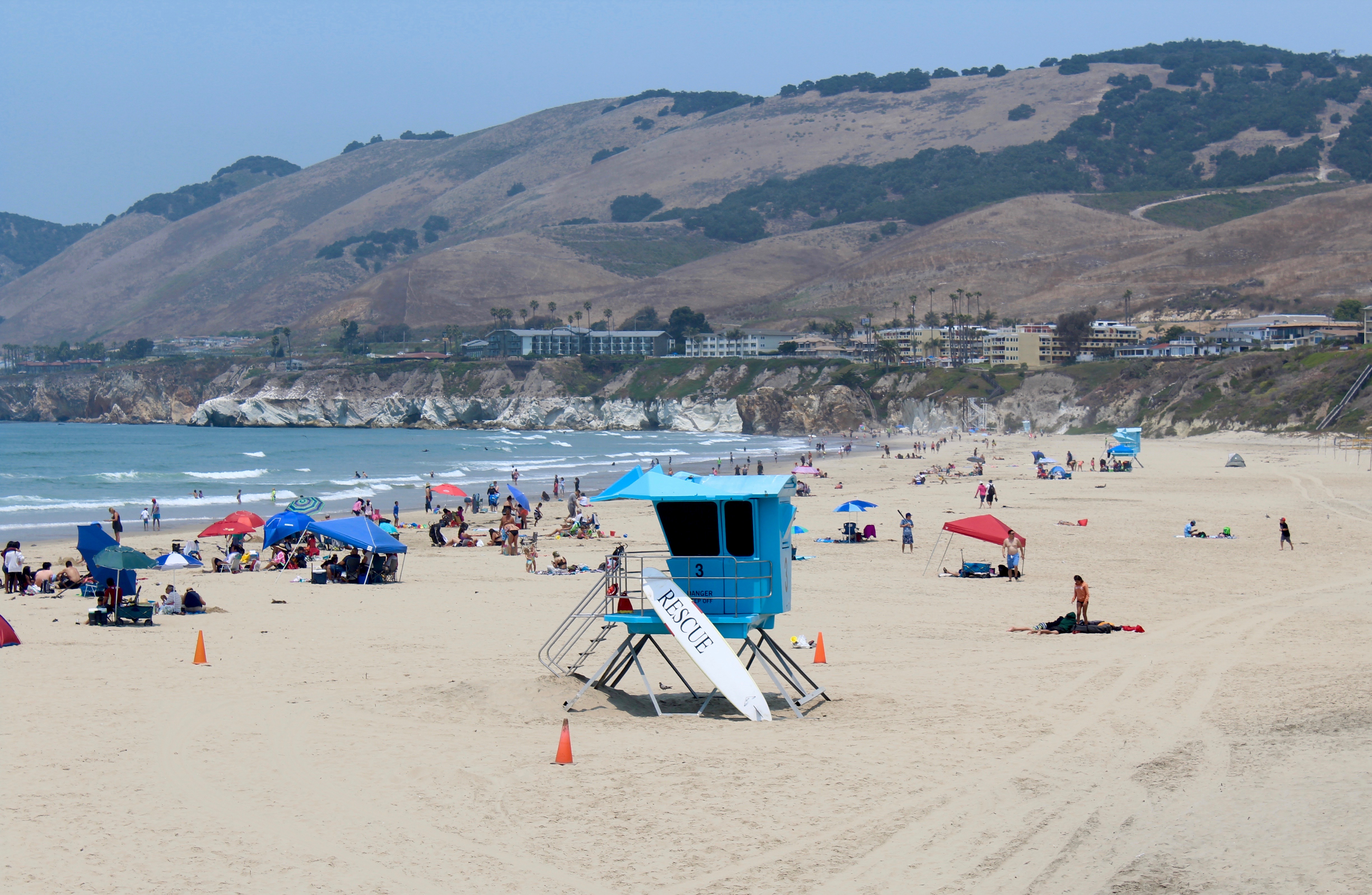
The pier is built over one of the finest sand beaches in the state and one of the luxuries of visiting Pismo is a good long walk along the beach at sunup or sundown. People will be strolling, joggers will be jogging, lovers will be… holding hands, and the seabirds, as always, will be looking for food.
On shore, depending upon the season, godwits with their straight bills, and curlews with their curved bills, will be foraging in the sand for aquatic worms and small molluscs (until disturbed by those walking into their area).

When anchovies or sardines are in the water, pelicans will be diving, pods of dolphin may show up, and both may be accompanied by rafts of sea lions or seals, all interested in those belly filling baitfish. The sky will be filled with birds and people will scramble to the beach and pier to see the sight.

But while there was a time when this beach was the best place in the state to dig for Pismo clams, the numbers have decreased dramatically (especially the take of large clams). Like the clams, the number of fish has also decreased. Nevertheless, fishing can still be good.
The top fish for anglers at Pismo (although not #1 in numbers) is barred surfperch, the same fish that is caught south of Point Conception.

Good-sized Barred Surfperch — Picture courtesy Sheldon’s Clam Stand
Most of the other prized inshore southern species, fish such as spotfin croaker, yellowfin croaker, and corbina, will rarely, if ever, be caught this far north. Instead, the angler fishing the surf area will see the addition of large calico surfperch. Instead of stingrays, the angler is more likely to catch a skate (quite a few big skate are taken here). There are, of course, other species. Around the shallow-end pilings there can seasonally be good fishing for blackperch, striped seaperch, rainbow seaperch and occasionally a pileperch or rubberlip seaperch.
Further out, mid-pier to the end, one will catch barred as well as silver and walleye surfperch. Here, anglers will also catch kingfish (white croaker) but unlike more southern waters, far fewer numbers of queenfish. The far end of the pier seems best for flatfish, although I caught a nice fantail sole practically in the surf during a July visit in ’77. Most-often-caught flatfish are starry flounder but sanddabs, sand sole, and a few halibut are generally caught every year.
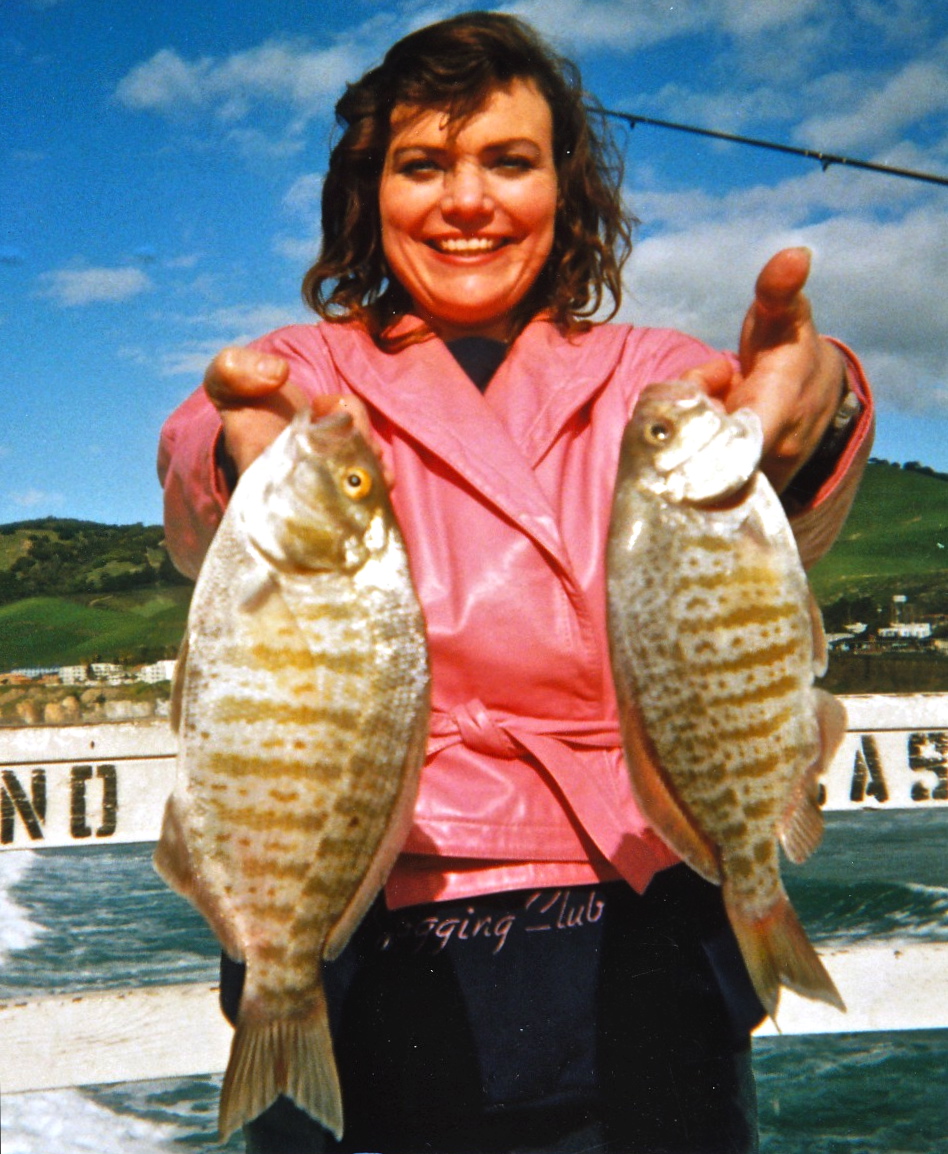
Barred Surfperch — Picture courtesy Sheldon’s Clam Stand
Pelagic species are most often jacksmelt (the #1 fish in numbers taken at the pier), Pacific mackerel and jack mackerel, but some years will also see a few barracuda, generally in September or October. Late spring to early summer seems the best time for halibut but mid-summer to fall is the best time to possibly hook a king salmon. Some years will still see schools of small bocaccio and these are usually found mid-to-late summer.
An unusual fish hooked in February of ‘02 was a steelhead trout estimated to weigh about 8 pounds. It was hooked on 6-pound test line with a small rubber grub and fought to the pier where it was lost (broke the line) when they tried to net it from above. Another unusual fish, caught on a Sabiki during August of 2008, was a juvenile sablefish, a fish more commonly encountered in deep water or from piers adjacent to submarine canyons.

Juvenile Sablefish
Interestingly, Fish and Game studies made back in the late ‘50s showed that Pismo was the only pier between this area and Trinidad (far to the north), to show a catch of common mola (Mola mola—the ocean sunfish). In 1958 twenty of the strange shaped beasts were caught from the pier although their ultimate fate isn’t recorded.
Fish and Fishing Tips. Follow the tide. Two hours before and after high tide, fish the surf area for barred and calico surfperch. Use sand crabs for bait if you can get some; if not, use seaworms, fresh mussels or clams. Use a high/low leader; size 4-6 hooks, and a sinker just heavy enough to hold your line behind the first set of breakers from the beach. For the largest perch, copy the regulars. More and more regulars use plastic grubs and they’re most productive right in the surf area or in the holes by the pilings. Although these perch can be caught year-round, the best times seem to be late January through March. Most interesting was the number of large barred surfperch landed in April of 1998. The largest weighed on a scale tipped out just less than 4 pounds; not bad considering that the state record for barred surfperch is 4 pounds, 2 ounces.
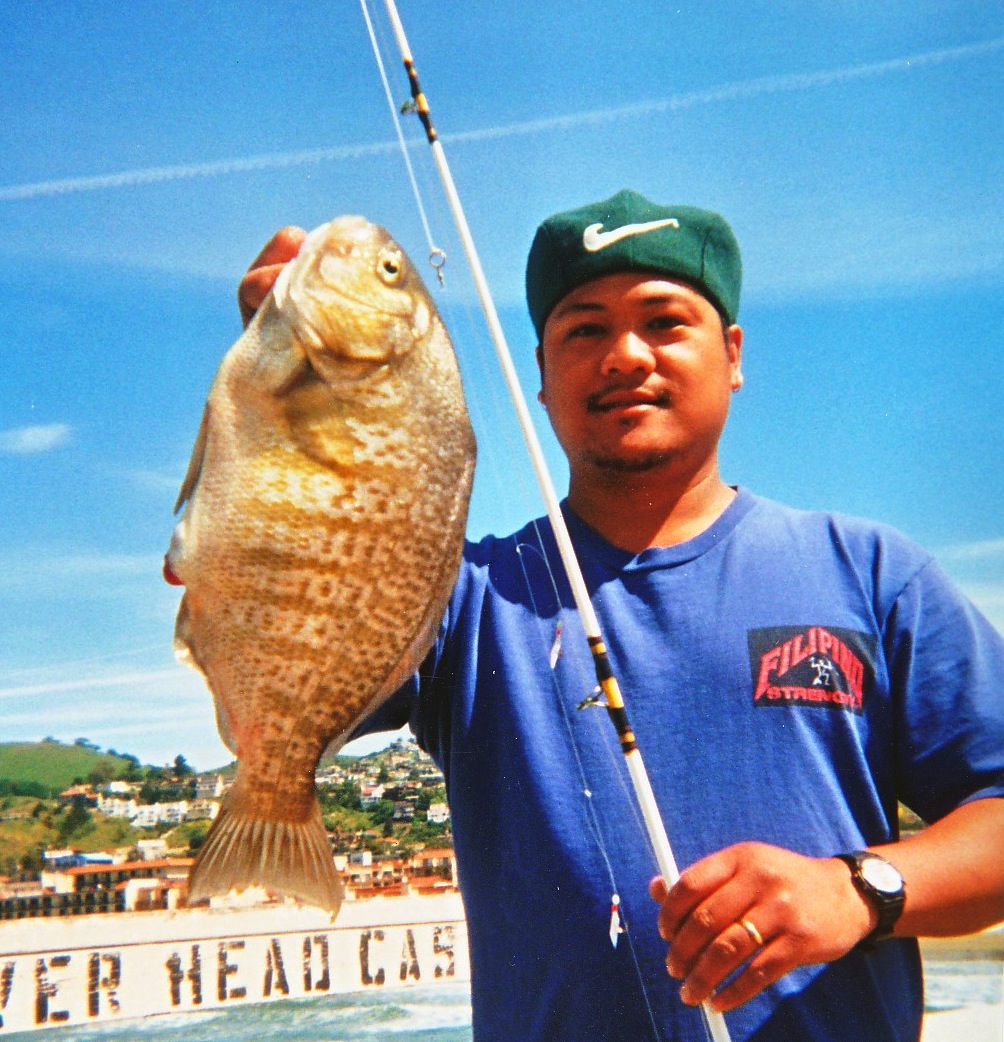
Barred Surfperch — Picture courtesy Sheldon’s Clam Stand
If perch are not your quarry, fish out toward the end for flatfish. In the winter and spring, fish on the bottom for starry flounder and an occasional Pacific sanddab. From the spring to the fall, fish for sole and an occasional halibut. The starry flounder and sand sole will hit a high/low leader baited with a strip on anchovy, bloodworm, ghost shrimp or even sometimes a sand crab. The smaller mouthed sanddabs prefer strip bait or worms. For the larger halibut, fish on the bottom using a live bait leader rigged with a small white croaker, smelt or walleye surfperch that are common to the pier. The larger plastic grubs and lures such as Big Hammers and Scroungers will also attract a few halibut.

Sand Sole
Perch are also found at the middle and end of the pier but here the more common catch is silver surfperch and walleye surfperch. Smaller hooks fished right down around the pilings often work best although the walleyes tend to school mid-depth. Walleyes love a small piece of anchovy while the silvers will also attack a small piece of clam, mussel, bloodworm or squid, as well as anchovy. If the rigging is allowed to reach the bottom, a few white seaperch may engage the angler. Joining the surfperch in the summer months, especially if it’s a warm-water year, will be some queenfish that have moved up from more southerly waters.
If anglers fish around the pilings with fresh mussels or seaworms, especially in the winter or early spring, the result may be a cornucopia of species—good-sized pileperch, striped seaperch, black perch, and even rainbow seaperch. With the exception of the pileperch, all are more common around rocky areas but they do congregate around the mussel-covered pilings.
Jacksmelt are the most common pelagic fish caught at the pier but Spanish jacks (jack mackerel), Pacific mackerel, and Pacific sardines will often also join in the fun. When the smelt or mackerel “are in” hoards will pack the pier and fill buckets with fish. Most of these will be caught out toward the end of the pier and most are caught on the multi-hook Sabiki/Lucky Lura-type bait riggings. I’ve had my best success by casting and reelin’ although at times a rig like these fished under a bobber or float works the best. Mackerel, by the way, seem to be very popular, especially for the Central Valley anglers. Seems the mackerel make great bait for the catfish back home in the Valley.

Jacksmelt — Picture courtesy Sheldon’s Clam Stand
If the schools of small bocaccio are present it will be hard to keep them off your hooks—but try. The youthful little fish may be the easiest fish to catch in the world and there has been a tremendous decline in the number of adult fish along the coast. Since one drop of a bait rig will often bring up three or more fish, and since the limit (as of 2006) is now one fish, with a ten-inch minimum size, the bottom line recommendation is to ignore them and let them multiply. Hopefully they’ll rebound and once again be plentiful
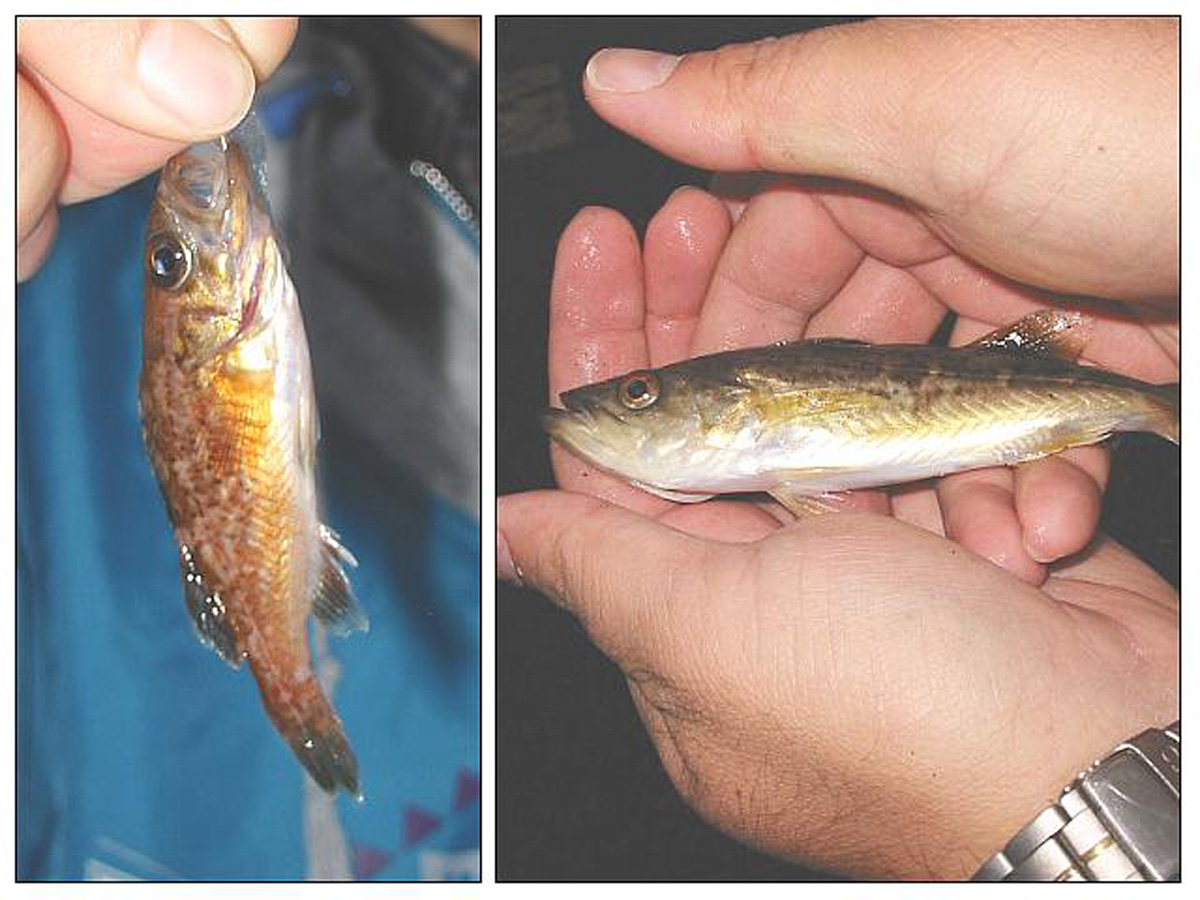
Baby bocaccio were once plentiful but today are illegal
Shark fishing at night is a time-honored tradition here. As long as the weather and tidal conditions are right, the shark “regulars” will visit the pier and often there will be quite a crowd. Anglers who want a little more solitude will move up to the Avila or Port San Luis piers. The most common sharks are dogfish, sand sharks (brown smoothhounds) and leopard sharks, but most anglers are seeking the larger bat rays and thresher sharks. Mixed in will be quite a few big skates, a few California skates (Raja inornata), and sometimes thornback rays and shovelnose guitarfish, two species more commonly taken south of Point Conception.
Sevengill sharks, although uncommon to the pier, have been reported and some were big. One report to the PFIC Message Board said that a 200+pound sevengill shark was caught from the pier in 1999. That’s a big fish if the report is accurate.

A Shovelnose Shark (Guitarfish) — Picture courtesy Sheldon’s Clam Stand
More common than 7-gills are the thresher sharks. Of interest are the thoughts of Troy Sheldon, from Sheldon’s Clam Stand on the pier. Troy, together with his father, ran the concession on the pier for over thirty years and was generally out on the pier five to six days a week. Troy felt that nighttime (the normal time for sharks) is not the best time for thresher sharks. He says that the best time for the threshers is in the late afternoon, especially when the wind has picked up and the water is a little choppy.
The Pier Rats Speak
Date: March 12, 1998: To: Ken Jones: From: Blaine B: Subject: H-o-l-y COW
Kapt’n Ken, The perch seem to be back in full force at the Pismo Pier. I went down today on the way home from work and this guy had the biggest perch I ever saw. They say he took it to the concession stand and weighed it at 4 lbs. but I have caught a lot of 4-pound spotted and largemouth bass in my day and I swear that sucker looked a lot bigger than 4 pounds. Anyway, a lot of folks had some decent perch in their buckets. Catch an Oncorhynchus for me… Blaine “Wishin’ I waz Fishin’”
Date: June 28, 2000; To: PFIC Message Board; From: cojoreef; Subject: (In reply to: Advice for Pismo Beach Pier
You might not believe me and that’s O.K., but 2 weeks ago I was fishing and this guy next to me hooked up with a 5-foot blue shark using the head of a Jacksmelt at the very end of the pier. I was about to gaff him and he bit through the line. What excitement! I gave this guy a steel leader and he landed a 3.5′ dogfish shark 30 minutes later. I would try mackerel, jacksmelt, and squid as a third choice for Pismo. This all happened around 12 noon. I don’t know what the nighttime scene is like, but these guys were saying they had caught a lot of sharks and their freezer was full for along time.
Date: December 22, 2000; To: PFIC Message Board; From: Got_Em; Subject: (In reply to: Seeking advice re Pismo Beach Pier
Cast out as far as you can at the end of the pier on the right side. I mean FAR. Chances are good for Dogfish Shark, Rays, Skates, and occasional Blue shark (lost one on the gaff). Smelt is most common live bait so be Sabiki ready. Chunks of Smelt, Mac, and squid produce well.
Date: May 20, 2002; To: PFIC Message Board; From: baitfish; Subject: Pismo Pier 5/18 5:30-7:30
Celebrating our 2-year anniversary we decided to head up to Pismo Beach and Hearst Castle for the weekend. We got in on Fri and walked around town for a bit, but when Rebecca saw me looking at the water like a forlorn puppy, she agreed that we could do some fishing WhhoooPeeee!!! 🙂
So we headed over to the pier in the late afternoon and the tide was just peaking out. We picked up some anchovies and clams at the bait shop on the pier and stopped off at the middle, to give it a shot. The wind was blowing reminding me of Berkley and I kept wondering, how do you nor cal folks put up with it??? Well the middle was not seeing much action so we headed over near the end and cast towards shore on a Sabiki rig tipped with small clam chunks.
I set that rod down and began setting up my larger rod when Rebecca is yelling at me that I have a hit. I set the hook ant in comes a gorilla Jacksmelt, the opposite of Joe’s rat corbina. This thing was at least 2.5 pounds. Then Rebecca hooks up with 2 one the same size as mine, and one a little smaller…Show off:-)
Of course she kept getting doubles and I was with my singles, but the second usually fell of before it got up to the pier. Sorry hon, doesn’t count unless you touch the leader or land it:-) hehehe We got around 8 of these bad boys and then the fishing died. No hits on my high low anchovy rig and Rebecca was shivering, so it was definitely time to go in:-)
Date: June 13, 2002; To: PFIC Message Board; From: pismo; Subject: Pismo Beach Pier
Fished from 6:30 pm to 8 pm. Caught 4 bat rays, all on squid (high/low). Others were also catching lots of jacksmelt. Also, Sardines, some quite large, have been around the last week or two. The Thornback bite seems to have tapered off quite a bit. John.
Date: July 28, 2002; To: PFIC Message Board; From: pismo; Subject: Pismo Beach Pier
Went out from 9 to 10:30 pm. Saw three dog sharks caught (one was mine), and a pretty big bat ray lying on the pier. I caught my dog on squid (high/low with size 2/0 hooks) and at least one of the other two were caught on squid as well. All released. Dog sharks, bat rays and thornbacks continue to be around in good numbers. John.
Date: June 12, 2003; To: PFIC Message Board; From: thepubliceye; Subject: Pismo Pier
Hello all, this is my first posting and report so please work with me! Went fishing from Pismo Pier from 6pm until 9:30 pm tonight, the wind (10 mph sustained) died down around 7:30 and the sky was clear and the moon was beautiful. From the start jack-smelt and sardines were biting on jigs with no bait until dark. I switched from my jig too a two hook leader with a slice of sardine on both hooks. It wasn’t 30 minutes later and I caught a halibut about 8 inches long. Just minutes after taking a picture it went back into the water. More to come Saturday night! Larry (thepubliceye)
—[Actually, the board decided it was a sand sole, not a halibut. KJ]
Date: September 12, 2003; To: PFIC Message Board; From: EddieE; Subject: Pismo Beach Pier Yesterday 9/11/03
Fished Pismo yesterday trying for a thresher but no luck there. I did manage to get 3 bat rays (2 ft or under), 1 leopard (lost in he pilings 5 to 6′), 1 dog shark 38”, lots of sardines, a few perch, a couple of jacksmelt, and one 12” mackerel.
Bait: Used unbaited Sabiki for baitfish and the sardines I caught for everything else.
Date: October 13, 2003; To: PFIC Message Board; From: Dscoots1; Subject: Pismo Beach Pier 10/13/03
This morning I got up at around 5:30am and went to make my morning pot of coffee. It felt a bit warm out so I walked out on the patio and could not believe it was about 74 degrees this early in the morning, especially here in Santa Maria. I thought to myself what a great morning to go fishing! 15 minutes later Coffee was in the thermos and I was off to Pismo Pier. 15 minutes later I was parking at the pier and rigging up my poles. You know the summer tourist season is over when there are only 4-5 surfers in sight. Ahhh this is going to be a great morning. No overcast, crystal clear views but wait a minute, HUGE SURF! Seawater occasionally sprayed up thru the cracks in the pier. Well, at least there is going to be lots of food in the water. Had my Carolina rig ready with a 1 1/2 oz egg sinker and about 18″ of leader.
With my #6 hook and my Kalin’s 1 1/2″ Perch Power lunker grubs ready, I threw out into the surf. Tangle after tangle I thought it was too rough. So, I moved out farther on the pier to 2 benches past the fish cleaning station. This is where the waves were breaking. And those waves were big. You could really feel the pier shake with each breaker. I sent out my lunker grub and before it even hit the bottom I had a bite. I landed a nice 1 1/2lb Barred Perch. I was getting bit on every cast and bringing in lots of the typical smaller barred perch. I just kept sending them back and hoping when they get bigger they will forget how untasty a Kalin’s grub really is.
Then like some-one turn off a switch the bites just stopped. The surf was calming down and I wasn’t getting a bite. I moved to the end next to the cleaning counter and sent my grub flying. While reeling in my pole bent and the drag started going out. I thought it was a big jacksmelt on how hard it had hit. It was fighting a good fight and I kept bring it in. Then I saw it flash. I nice big juicy Barred Perch! About 3 lbs! I had to handline it up. Ahhh dinner is served! Pulled in one more keeper about 5 casts later and called it a day. Gosh, I love fishing!
Date: November 23, 2004; To: PFIC Message Board; From: FakeFisherman; Subject: Pismo Beach Pier 11/22
So while making the drive down to SoCal from the bay area for Thanksgiving this week, I had to hit up at least one pier on the way down. Decided to visit the Pismo Beach Pier since I had passed it so many times and never fished it.
Got there around 5:30pm (just missed the sunset!). Threw out 2 poles between my friend and I using hi/lo’s with bloodworms and the first 15 casts or so resulted in one to two barred surfperch every cast…all released. They were no bigger than 7″ but still a lot of fun. Another guy there had what looked like his limit of nice-sized ones using shrimp and mussels—I think he got them right before sunset. Some other fishermen grubbing, but didn’t see them catch anything.
Potpourri — More Than You May Want To Know About The Pismo Beach Pier
<*}}}}}}}}}>< — In April of 1991, I took a fishing trip along the California coast. Conditions were wrong but it was the only time I could take the trip. Tides were poor, the weather was iffy (as in cold and overcast), and the water was very dirty with plumes of sediment poking out into the ocean all along the coast (because of torrential March rains which had followed several months of drought conditions). I had fished at 11 different piers between Imperial Beach and Gaviota and the fishing was poor, in fact, not just poor, but terrible. It was sort of a bad hair day times five, every day seeing failure on a different set of piers. On my way home I almost decided to skip the Pismo Beach-Morro Bay area piers, an area where I normally would stop to fish. But I still had some bait left ncluding some ghost shrimp I had purchased in San Diego. Why not give it a shot? I stopped at Pismo Beach and headed out to the end of the pier. Huge waves were breaking out toward the end of the pier, shaking the pier. Evidently the waves had convinced most anglers to call it a day since not too many people were fishing. Soon I was fishing and once again repeating my lack of success. Nothing would bite on anchovy or mussel. Finally, I tied on a whole ghost shrimp and immediately started to get bites but no fish. Wondering if the bait was too big, I cut a ghost shrimp into three pieces. Now I began to catch fish, one or two on every cast on my hi/lo rigging. The fish were fat little barred surfperch and very good-sized walleye surfperch. Unfortunately I only had four ghost shrimp left but I caught 12 fish on those shrimp. No other baits worked but those shrimp saved that trip to the pier for me.

Barred Surfperch — Picture courtesy Sheldon’s Clam Stand
<*}}}}}}}}}>< — One day I was calmly gritting my teeth and nodding approvingly as my doctor stun-gunned my face and asked if I was OK. The ”this might sting a little” routine had out lived its usefulness but I would show my manliness and toughness by refusing to show the pain (and there was pain). Following the masochist session we talked of fish. She asked if I had ever heard of dog sharks? “Yes, but they are actually called dogfish sharks, so called because they travel in packs like dogs.” She said she had been at the Pismo Pier in August (2013) when she had seen 50-60 dog sharks, most around three feet in length, laying on the deck at the end of the pier. Anglers were bringing more sharks up every few minutes. It was dark and as she had looked down into the waters she said she could actually see the sharks massed below. I asked if the anglers had said what they intended to do with the sharks and she said they were going to eat them. “Good thing,” I said, “since I hate to see fish wasted.” No wonder a lot of guys like to fish the pier for sharks!
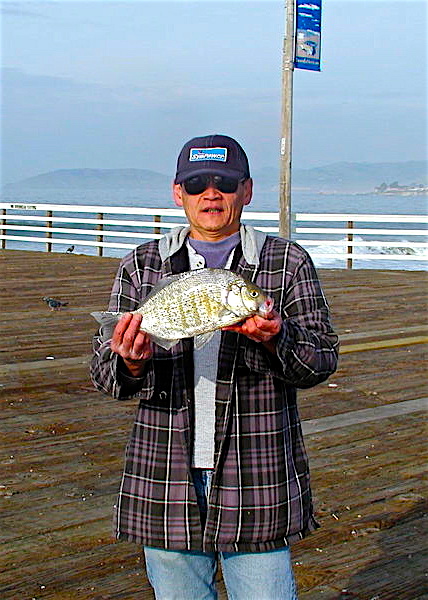
Barred Surfperch
<*}}}}}}}}}>< — In 1950 papers reported the capture of a strange pier from the Pismo surf:
Rare Wolf Fish Caught In Surf At Pismo Beach
A vicious killer of the sea, a rare wolf fish, one of 14 recorded as caught in California waters since 1892, is under study by marine biologists at the California Division of Fish and Game at the marine laboratory, Terminal Island. The rare deep-sea fish, known officially as Alepisaurus aesculapius, was caught in the surf at Pismo Beach recently. One other was caught in the surf at Redondo Beach in 1938.
Capture of the Alepisaurus aesculapius at Pismo Beach made a story in itself. A little girl, playing in the breakers first spotted the wolf fish and screamed when it snapped at her. Harold Foster of Pismo Beach, digging clams nearby, grabbed the fish by the tail and hurled it up onto the sand… The wolf fish, according to John Finch, biologist in charge of the rare fish division of the Bureau of Marine Fisheries, gets its name from its wolflike head filled with saberlike teeth and its sleek appearance.
Measuring more than four feet long, the specimen caught at Pismo Beach carries a guge fin on its back similar to that of a sailfish. It is believed to be a deep-sea fish, although all of those caught have been found in the surf. Marine biologists believe that fish come into shallow water to rid themselves of parasites. They are more common from Washington to Alaska.
The fish apparently has a voracious appetite, according to Fitch. One specimen had the following in its stomach: one 10-inch long eel, 5 ribbon fish, 21 small Pacific mackerel, 53 rockfish, 7 small flatfish, 1 pipefish, 66 small octopuses, 5 squid, 20 unidentified fish and numerous shrimp, tunicates, amphipods and capepods.
The fish has a long barracuda-like body, but when it comes up from deep water its muscles apparently relax and bones of the back separate, Fitch said. Skin of the fish is a bluish-green color with the big sail fin a dark blue…
—Los Angeles Times, February 23, 1950
<*}}}}}}}}}>< — Although perhaps little remembered today, Pismo Beach was once a famous destination for Bugs Bunny. In several films good old Bugs was headed to “Pismo Beach and all the clams you can eat!” when he failed to take the correct turn at Albuquerque. Eventually he would emerge from a tunnel asking, “Is this the way to Pismo Beach?”
The reference reflected the fact that the city was once known as the “Clam Capital of the World” for the numerous Pismo clams found on the beach. Today, the tasty mollusks are largely gone even though there is still a large concrete statue of a clam on Price Street (near the entrance to town), and a “Clam Festival” is held every October— complete with a clam chowder competition and a clam-themed parade. But the number of clams has dropped, clamming itself is restricted, and the clams used in local restaurants are mostly brought in from other venues.The argument as to why the clams are gone, and who is most to blame, seems unending—and it’s a toss up among locals between the resurgent numbers of protected sea otters (that go giddy over clams) or over the clammin’ by clam-hungry clammers. Take your pick (although Note #4 gives evidence of the tremendous numbers taken during the early days).
Bugs & Pismo Beach — https://www.youtube.com/watch?v=qSzTDK5TAfY

Confirming the decline in the number of clams was the California Fish Bulletin #96 from 1953 that said: “The town has been famous for its long stretch of beach but especially for the delicate flavor of its clams. Pismo clams, once unbelievably abundant from Monterey Bay into Mexico, made their last stand in the United States against practical extinction at Pismo. In early days the clams were uncovered by a horse-drawn plow and carted away in farm wagons. Later a clam cannery operated at the edge of town (1902–1914). As tourist and commercial digging decreased the clam supply, more stringent protective laws were passed till finally the sale of clams was prohibited in 1947. The town has a fishing pier but there are no other facilities. The records for Pismo show little else than clams. The average annual take figure was about 85,000 pounds but the peak year of 1937 showed 172,000 pounds. There have been no fish landings of any kind since 1949. Sport fishing is chiefly clam digging with pier fishing and some surf casting.”
<*}}}}}}}}}>< — Publicity, but not necessarily the type of publicity the city desired was recorded in 2007 when the city announced plans to trap and kill the pigeons rooting on the pier.
City plans to kill pigeons as way of cleaning up ocean?
The July 19, 2007 online SignOnSanDiego.com ran an Associated Press report, with information from the Santa Maria Times, on the plans of the City of Pismo Beach to kill pigeons roosting on the Pismo Beach Pier.
It is stated that the pigeons will be trapped and killed by a pest-control firm, possibly as early as August, and then taken to Paso-Robles-based Zoo to You to be fed to the animals there. What means will be used to kill the pigeons is not specified.
Also not specified is what will be done with nestling pigeons, and whether or not any consideration is being given to preventing young fledgling pigeons who can fly, but who cannot feed themselves, from dying of starvation, if they are not all caught in the traps. The article generally makes light of the fate of the pigeons.
The stretch along this part of the beach has been closed due to high levels of bacteria. There appears to be no evidence linking high levels of bacteria in the water to the presence of pigeons, and there has been speculation that there may be a sewage leak, which is causing the problem. High concentrations of E Coli and other bacteria have been found in the water, causing health officials to post repeated warnings.
A new feeding ban ordinance was passed recently, and the plan was originally to wait until November to see whether or not the ban has led to the departure of the pigeons. The plan to hire the pest control firm for six months may cost $30,000.
—Sharon St. Joan, Best Friends Network, July 31, 2007
Pismo Beach Needs Hollywood Pill —The Birds Are Still Flocking To The Pier
The Pismo Beach Public Works Department hasn’t seen any decrease in the plethora of pigeons frequenting Pismo Pier looking for free food since feeding birds at the pier became illegal last month. And on Tuesday, the City Council will again discuss the controversial option of hiring someone to trap and kill the birds, which are suspected of polluting ocean water near the pier.
Public Works Director Dennis Delzeit also said he and his crew of 30-plus employees haven’t seen the individuals who are known to bring large bags of food, mostly bird seed, to the pier area to feed the birds.
City staff believes the “bulk feeders” are contributing to the huge pigeon population at the pier and in the pier parking lot at the end of Pomeroy Avenue as well as at the Cypress Street Bridge. “We’ve been on the lookout” for them, too, Delzeit said about the bulk feeders. “We don’t know if they’ve stopped the feedings or if we’re just not down there at the right time to see them.”
Delzeit added the city has “no proof” that bulk feeders are contributing to an increase in the number of pigeons at the pier, but instead are basing the belief on expert opinions, like those of the People for the Ethical Treatment of Animals.
Representatives from the animal rights organization that’s headquartered in Norfolk, Va., recently came to Pismo Beach to meet with Delzeit and the city manager after learning the City Council was considering a trap-and-kill program to deal with the pigeon problem. “PETA has confirmed that in other situations, pigeon populations will increase dramatically with just one bulk feeder,” Delzeit said. “We think that’s why we’ve seen such a huge increase in the number of pigeons at the pier (in the last few years).”
—April Charlton, Santa Maria Times, August 19, 2007
<*}}}}}}}}}>< — My grandson Adam is a big fan of Sasquatch and gets a kick out of watching the search for the legendary creature on TV. Imagine my surprise to see that Sasquatch had been spotted surfing next to the Pismo Beach Pier. I told Adam we would have to head over to Pismo Beach if he wanted to spot Bigfoot. After reporting the sighting on PFIC one member wrote in “I have seen Santa surfing next to the Seal Beach Pier but never sasquatch. ”The story was reported on About.com:
Surfing Sasquatch Takes Over My Fishing Spot
I’ve seen some funny stuff over the years, but when I went to fish off the Pismo Beach Pier in Calif. on Sunday and saw a surfing sasquatch, I had to share. Sure, it didn’t have a whole lot to do with fishing, but it prevented me from doing much fishing on this day (which doesn’t happen a whole heck of a lot, so I had to mention it). While attempting to haul in some surf perch on this Sunday, here’s the scene that I ran into: This guy was catching waves like crazy, which not only was spooking my fish, but was raising all kinds of noise from the fans on the pier. In any case, it was fun to watch, and made me a believer in Satch thesurfing sasquatch.
—Brian Milne, About.com, September 30, 2013
http://www.sasquatchsurfshop.com/2013/09/29/bigfoot-surfing-in-pismo-beach/
<*}}}}}}}}}>< — For the past two decades the number of great white sharks reported in waters from Pismo Beach to San Simeon has seemed to increase each year. Many are seen from the piers and a few have been hooked — and landed, even though such an act is illegal. It has put fear in the minds of some people and created various conflicts between surfers and fishermen.
Great white sharks seen in Pismo; surfers blast chumming online
Multiple sightings of great white sharks off the coast from Cayucos and Morro Bay to the Pismo Beach Pier have been reported this week, and some surfers say fishermen are creating a potential hazard in popular surf spots by chumming, or dumping fish remains off the pier to attract the sharks.
On Friday morning, fisherman Pete De la Torre of Santa Maria and his 12-year-old son, Eddie, who regularly fish off the Pismo Beach Pier, said they saw a 6-foot shark they believed to be a great white.
“It was dark and was kind of scoping out the area before it swam out to deeper waters,” De la Torre said. “It was shocking to see one up close.”
Grover Beach surfer Mike Schwartz, who regularly surfs in the area, said he was surfing off the north side of the Pismo Beach Pier on Tuesday evening when he saw a giant fish — about 6 to 7 feet — that appeared to be a shark.
When he got out, a girl visiting from Oklahoma showed him photos she had taken of the shark.
“I just spotted it swimming by,” Schwartz said. “After looking at the photos, it wasn’t a thresher, which have those elongated, pointy tails. It had the characteristics of a juvenile great white shark.”
In online discussions, surfers recently have blamed fishermen for chummingto attract sharks off the Pismo Beach Pier.
Using the handle “inhabitoryresidue,” Schwartz recently wrotein an online discussion: “I have witnessed fisherman discussing and rigging their rods expressly for catching ‘the shark.’ ”
Schwartz continued, “Do you put a 2-inch circle hook through the middle of a 10-inch smelt to fish for halibut off the pier?? I think not. Whether these actions could lead to a surfer being attacked is debatable, but the fact that they are trying to catch ‘the shark’ is not.”
An Instagram post by “dave.morgan_” added, “Maybe some police signage on jail time if anyone injured due to chumming. Could squeeze in something about hooking surfers as well.”
In another Instagram post, Walt Cerny, who goes by “stillfrothy,” urged the city of Pismo Beachto “please monitor that for all of our safety. Not cool!!!”
De la Torre, who fishes for perch, mackerel and smelt, said that he has witnessed some chumming taking place. But he said it was infrequent, and he hasn’t heard of anyone fishing for great whites.
“I have seen people going for the threshers,” De la Torre said. “Sometimes they use a big hook and rope and just haul the thing up.”
Schwartz said that he heard of a catch that was likely a great white.
“I wasn’t there, but I heard from a credible source — I won’t give out any names — that some fishermen off the Pismo Beach Pier recently hauled in a shark that appeared to be a juvenile great white,” Schwartz said. “They gaffed it and used a crab net to get it up on the pier.”
Under state Department of Fish and Wildliferegulations, it’s illegal to fish for great whites unless the catch was incidental; even then, fishermen are supposed to release them immediately.
“People aren’t supposed to be targeting great whites for fishing,” said Carrie Wilson, a Fish and Wildlife marine biologist.
Chumming is legal, Wilson said, but added that wardens do frequent the area to make sure illegal behavior isn’t going on.
Wilson said people who see illegal fishing behavior are asked to report it to the department’s Cal Tip line at 888-334-2258.
Despite the sightings and fears about the type of fishing taking place, some surfers say they won’t be deterred from riding waves.
“There’s so much food for sharks in the form of wildlife around here that some chumming probably won’t make a difference to attracting sharks,” said Tim Kelley, a Morro Bay resident who surfed by the Pismo Beach Pier on Friday. “I have noticed fewer surfers in the water of late, however, especially in Morro Bay, where the attack took place last year. I try to surf a little closer to other people.”
—Nick Wilson, San Luis Obispo Tribune, July 8, 2016
After surfers and paragliders continued to report large shark sightings from Cayucos to Morro Bay, video evidence of a large shark swimming next to the Pismo Beach Pier surfaced on social media Saturday.
A video taken by Arroyo Grande teen Joel Bishop shows what appears to be a great white shark swimming just off the pier at the popular Pismo Beach.
Longtime local surfer Walt Cerny shared the video on his Instagram page. “More sightings in 3 last weeks than I can recall in the last 30 years,” Cerny wrote.
Andy McKay, who owns Surfside Donuts in Pismo Beach with his wife Carin, shared another video taken Saturday that shows a similar sized shark that also appears to be a great white. McKay said he was walking with his wife shortly after 8 a.m. when they saw the shark a little more than three-quarters of the way out on the Pismo Beach Pier. He estimated the shark to be about 8 feet long.
A juvenile great white shark was caught and released early Saturday afternoon at the Pismo Beach Pier, according to Todd Tognazzini, patrol lieutenant at the California Department of Fish and Wildlife.
Fish and Wildlife received a call from the Pismo Beach Police Department at 12:50 p.m. Saturday with a report that a juvenile great white shark measuring about 4 1/2 feet long had been caught.
The shark had already been released by the time authorities from Fish and Wildlife arrived on scene, but they were able to review video footage of the capture to ensure that the shark had been properly released.
It is legal to catch great white sharks as long as the animal is both caught and released properly; the shark must be uninjured and released immediately, Tognazzini said.
This is the second reported incident of a great white shark being caught off the Pismo Beach Pier recently. Authorities are seeking information regarding a juvenile great white shark that was caught a couple weeks ago that may have been injured before being released, Tognazzini said.
According to information the department has received, the shark may have been caught using a gaff hook — a very large hook used to land fish. The hook can often harm fish, and it’s illegal to use a gaff hook on fish that are illegal to catch.
It appears as though the great white shark was possibly gaffed and then brought onto the pier where photos were taken with it, Tognazzini said. It appears that the shark was not immediately released.
Authorities are offering a reward for information about the incident. Anyone with information is encouraged to call the anonymous CalTIPnumber at 888-334-2258.
—Travis Gibson and Danielle Ames, San Luis Obispo Tribune, July 10, 2016
Great white shark caught illegally on Pismo Beach Pier; Wardens seek man in photos
The California Department of Fish and Wildlife has released photos of a man they’re seeking in connection with the illegal capture of a great white shark on the Pismo Beach Pier.
One of the photos shows the man posing with the juvenile shark while bending its snout upward for photos.

Great White Shark (Photo courtesy California Dept. Fish & Wildlife)
The shark, which was said to have been gaffed and hauled onto the pier, was caught June 22 at about 6 p.m. The DFW is asking for the public’s help in identifying the man.
“You are not supposed to pose with the animals,” DFW spokesman Todd Tognazzini told the San Luis Obispo Tribune.
Great white sharks have been protected in California waters since 1994. While it’s not illegal to hook them, incidentally, anglers are supposed to release white sharks as soon as they’ve made an identification.
Anglers who are unsure whether they’ve hooked a white shark are supposed to cut the line. White sharks cannot be gaffed and landed.
The illegal capture of a white shark can result in a misdemeanor charge with a maximum fine of $1,000, or up to six months in jail.
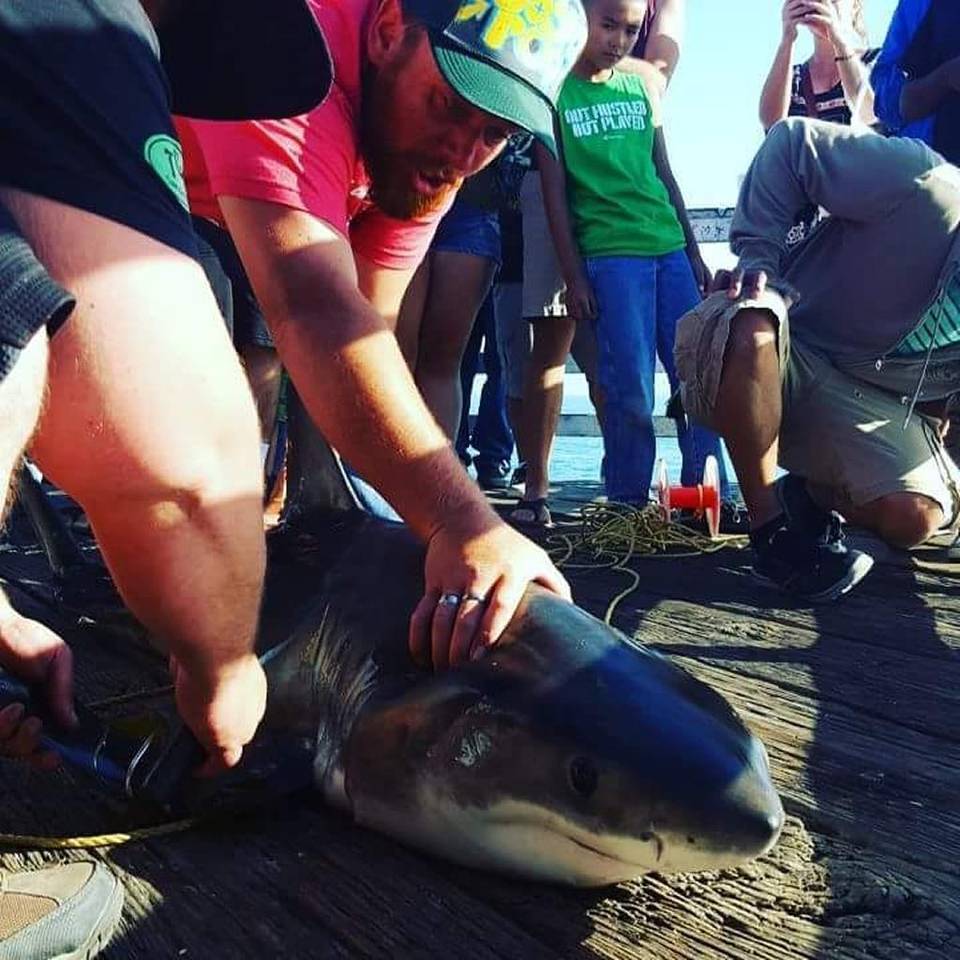
Great White Shark (Photo courtesy California Dept. Fish & Wildlife)
*Tuesday night update: The angler referred to in this story turned himself in after being identified by citizens who saw his photograph in the news.—Pete Thomas, Grind TV, July 12, 2016
History Note. The first local pier/wharf was built here in 1881. It was built by a group of San Francisco businessmen led by the Merherin brothers (from nearby Arroyo Grande). Their wharf was 1,600-foot-long, twenty-seven feet above the low water mark, and was primarily used as the shipping point for south county agriculture. The original cost was only $14,613 (compared to the more than one million dollars spent to restore the pier in the 1980s). Near the entrance to the wharf set two warehouses and a small, handcar track for moving cargo led out to the end of the wharf. In 1882 thirty-eight vessels loaded at the wharf and business would continue steady until the mid-1890s when the pier suffered damage.
Interestingly, it was not until ten years after the wharf was built, in 1891, that the town of Pismo officially came into existence (derived from the Chumash Indian word pismu, the naturally occurring asphaltum tar that seeps through fissures in the ground and sea floor). The town’s character was changed forever when the Southern Pacific Railroad built a line from San Luis Obispo to Ellwood in Santa Barbara County. The railroad brought hoards of visitors to the beach and Pismo became a tourist destination. By 1895 hotels were flourishing and the “Tent City” with its $8.00 a week rates was built to handle the excess of tourists. Located where today’s Boardwalk Plaza Mall sits, the “Tent City” would last until the late 1920s. 1895 also saw a dance pavilion built at the foot of the pier; it too would last until the 1920s. The influx of summer visitors caused the city fathers to change the town’s name to Pismo Beach in 1904.

Advertisement in the Los Angeles Times, July 7, 1908
“Port Harford is the well-protected harbour of San Luis. A short rail line and the Camino Real run to it. A little way south is Pizmo Beach, which is an extraordinary floor of hard-packed sand extending for 20 miles between long rocky arms… In winter it is as lonely as it is vast and sonorous with the boom of the surf. But summer finds it alive with throngs who dwell for the most part in tents and cottages, and consume with limitless appetite the fine-flavoured clams of this strand. Over the firm shining track, many fast motor-races are run.—Ruth Kedzie Wood, The Tourist’s California, 1915
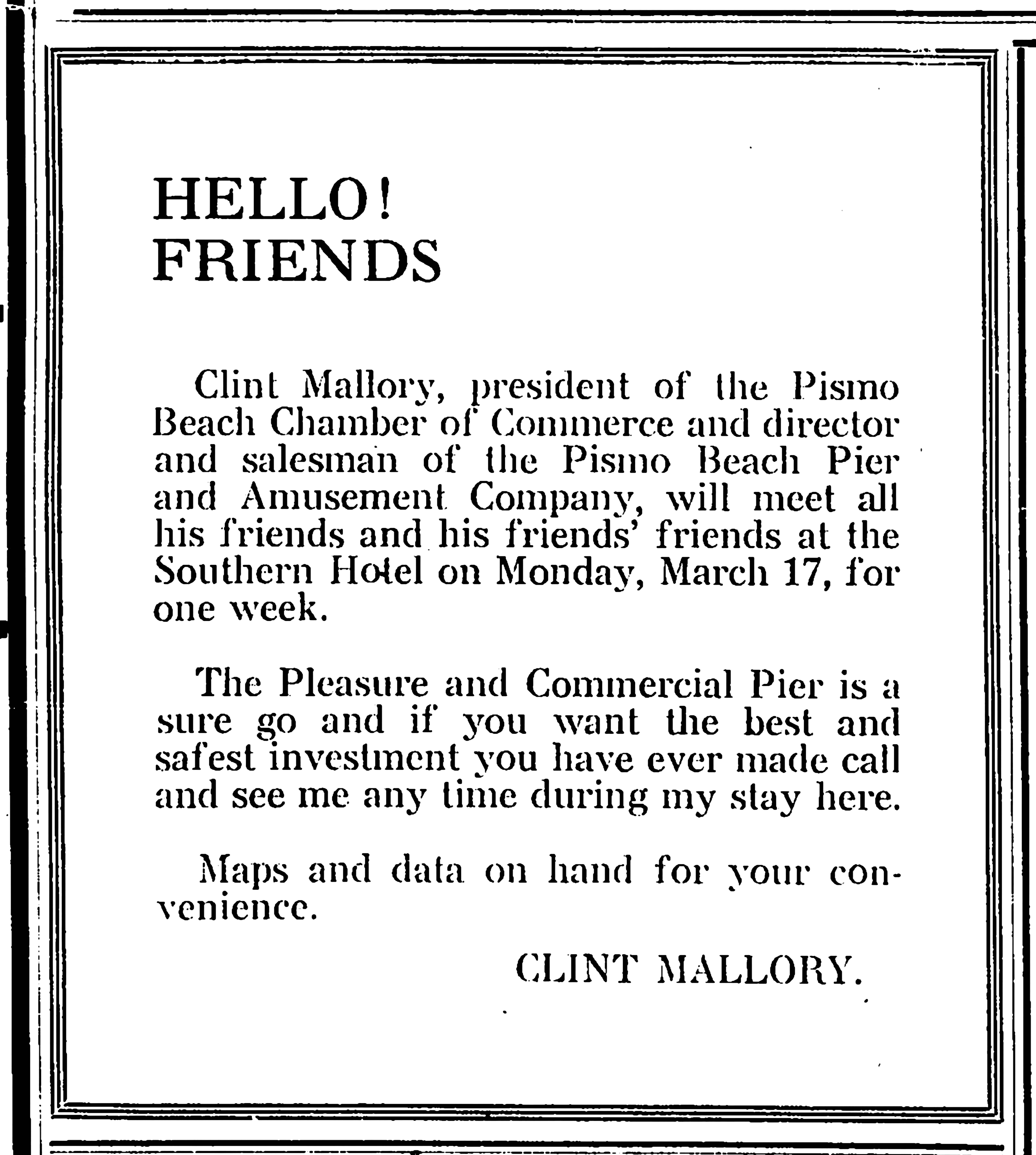
An advertisement in the Bakersfield Californian — March 14, 1924
A new, longer and wider wharf was built in 1924 but, like most wharves and piers, suffered sporadic damage from the elements. 500 feet at the end of the wharf was lost in a storm shortly after it was built. Additional damage took place in 1952.
Heavy Seas Damage Pier At Pismo Beach
Pismo Beach, San Luis Obispo Co., March 15.—County employees today worked in rain and wind to salvage materials from the wreckage caused to the 1,200 foot pier during the storm last night and early this morning. The damage to the pier was estimated at more than $25,000.
Chief of Police Amos Dana reported that about 150 feet of the portion of the pier which extends farthest into the water was knocked down by a heavy sea whipped by high winds. Crews were busy with trucks picking up huge pilings which had been knocked out from under the pier and cast up on the beach. The pier broke off just beyond the bait concession house, Dana said, and no one was on it at the time.
—Fresno Bee-Republican, March 16, 1952
Repairs were made and fishermen continued to catch fish: “There is one item from Pismo Beach: Pier fishermen have been taking a fair number of salmon.” — Fresno Bee-Republican, October 4, 1968
That storm was mild compared to the El Niño storms of 1983 that necessitated a total rebuild, work that was started in 1985. Money came from the City of Pismo Beach, the Wildlife Conservation Board, the Coastal Conservancy, and FEMA. The pier reopened in 1988 and seemed one of the best built and most visited piers along the central coast until 2016 when the city decided the pier needed rehabilitation.

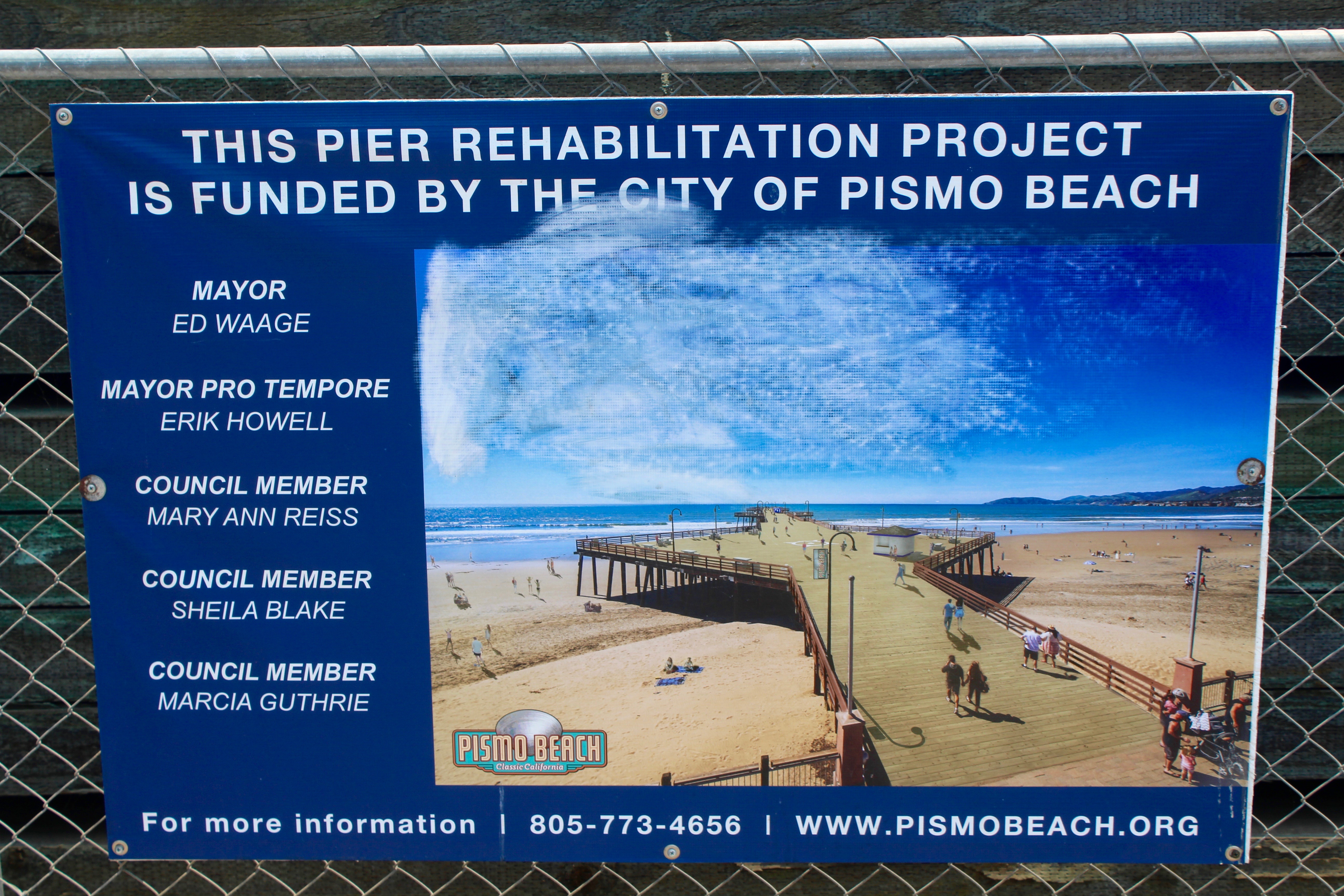

The pier reopened on October 20, 2018 far ahead of schedule and under budget (which seems unheard of today). The beautiful new pier was quickly engulfed by visitors, locals and anglers ready to wet a line after their forced absence.

During reconstruction the sea gulls and pelicans had the pier for their home. Of course there was no bait or hooked fish to steal for food.
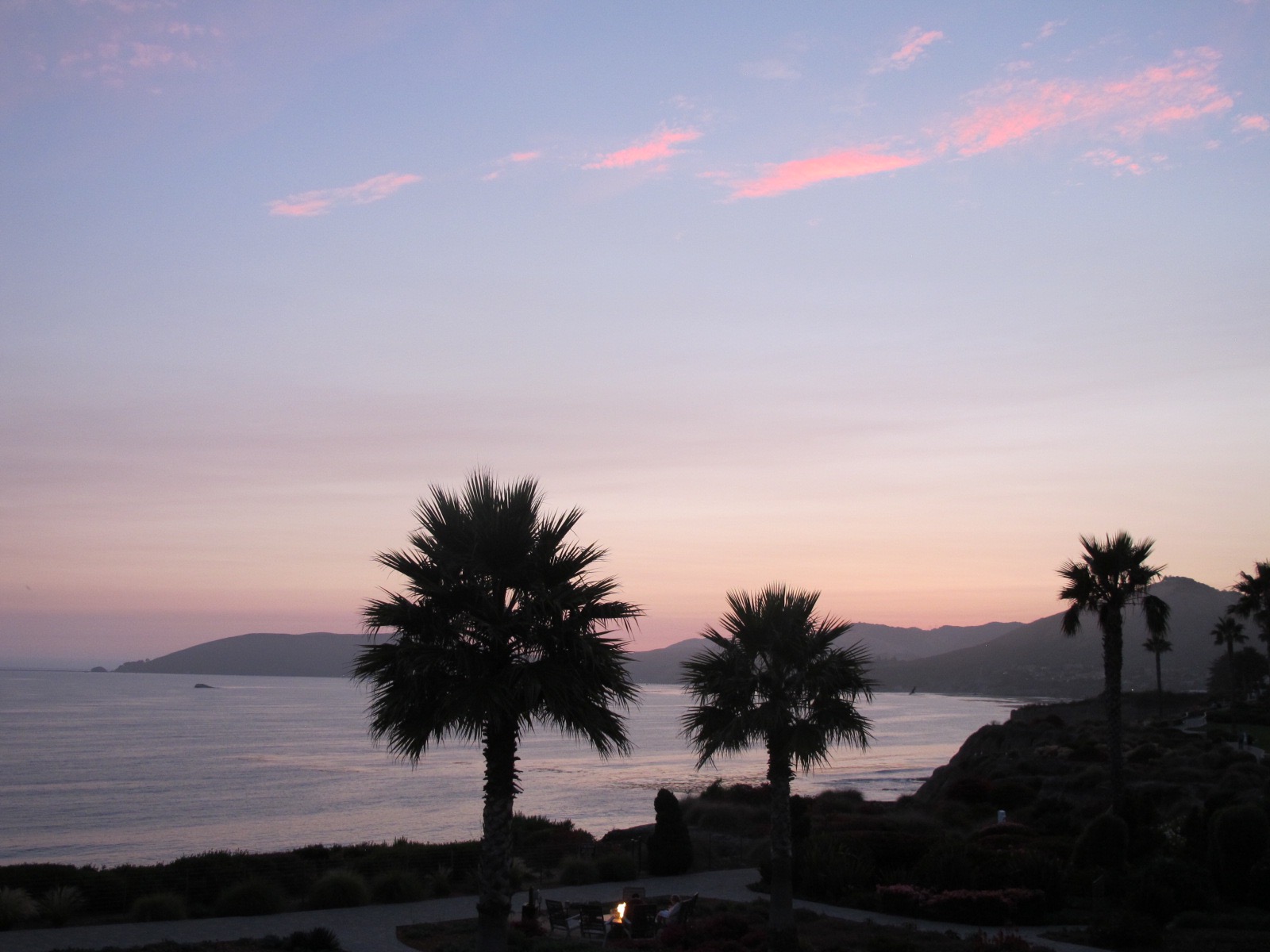
Sunset at Pismo
Pismo Beach Pier Facts
Hours: Open 24 hours a day.
Facilities: Restrooms and free parking is available at the foot of the pier. The signs indicate a 4-hour limit from 9 a.m. to 6 p.m. and no parking from 11 p.m. to 4 a.m. Fish-cleaning stations, benches, lights, bait (primarily frozen) and tackle are available on the pier. Some food is also available at the pier bait and tackle shop.
Handicapped Facilities: Handicapped parking and restrooms. The surface is wood planking and the railing is 42 inches high. Posted for handicapped.
How To Get There: From the north, take Hwy. 101 to the Five Cities Dr. exit; follow Dolliver into the middle of town, then turn west on Pomeroy and follow it to the pier and parking lot. From the south, take the Pismo Beach Exit (Price St.), follow it to Pomeroy; turn west and follow it to the pier.
Management: City of Pismo Beach.
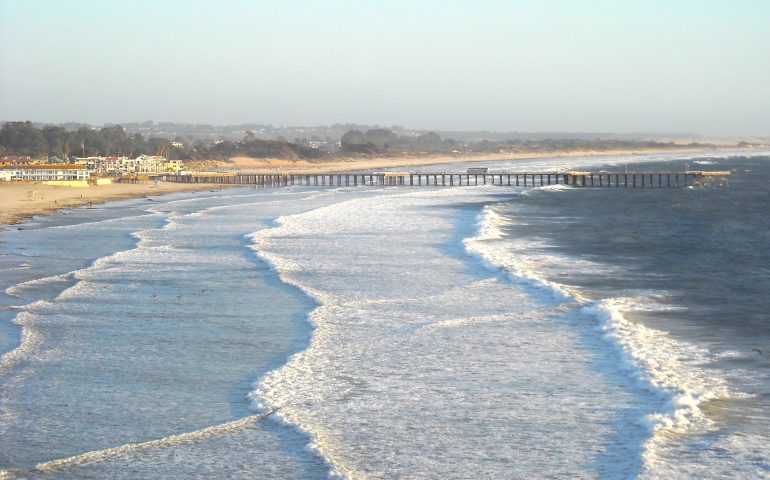
Is the Pismo beach pier open this month, March 2019?
Is there a local store where I can rent fishing poles, reels, bait for pier fishing?
The recent renovation has been completed and the Pismo pier again open all year. Rods, tackle and bait are available at the shop which is located at the base of the pier. The shop is open on weekends and most weekdays. However, at times it does not open until 11:00 AM.
What type of fish are people catching? What type of bait are the using? Is the pier close to the camping area?
Their 1,600-foot-long wharf, which stood 27 feet above the low water mark, was mostly utilized as a shipping port for agricultural products from south county.